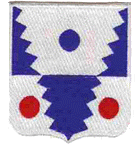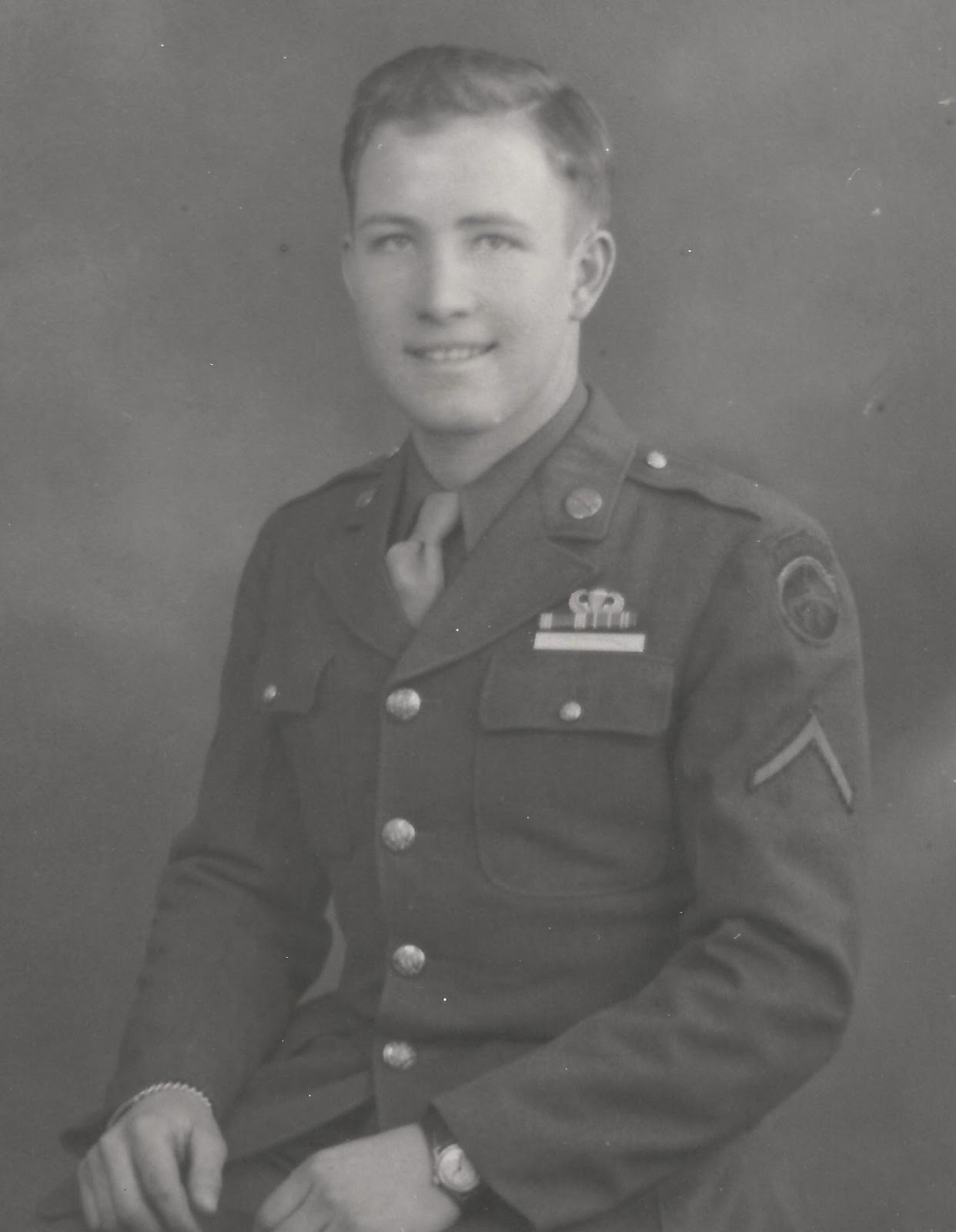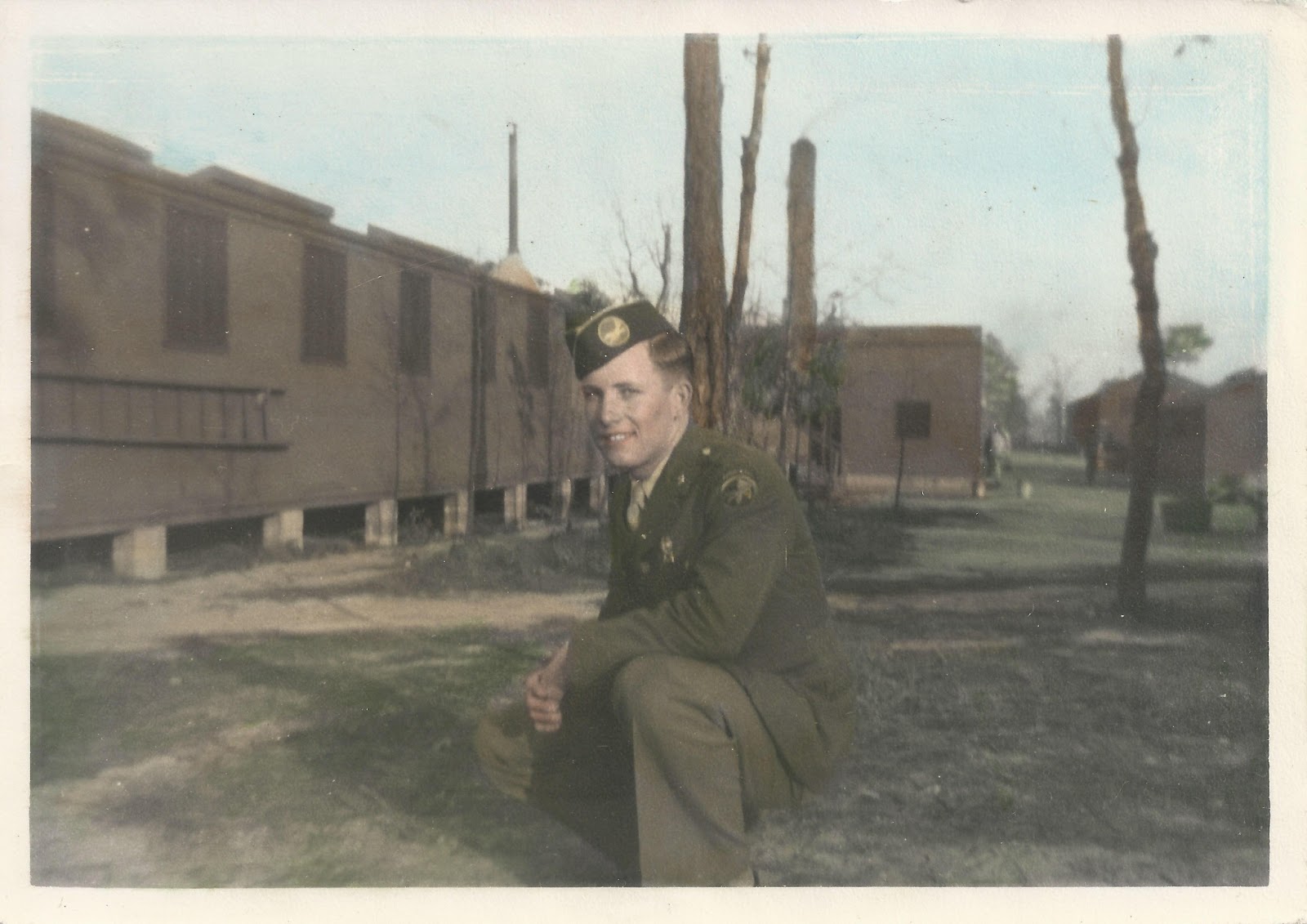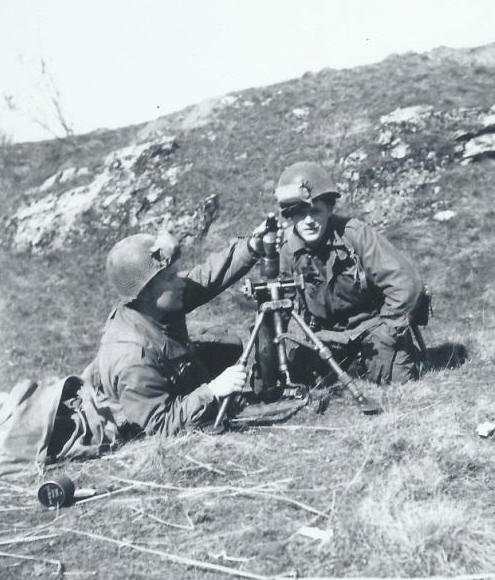
Melvin M Lagoon
Many thank you to Gregory de Cock for the article about Mel. Thank you Mel and his family for their kindness.
|
IN MEMORIAM |
|
It's with great sadness that I must inform you of the death of Mel Lagoon. He passed away on December 10th, 2015 to the morning. Rest in Peace Mel, thank you for all! My son was very proud to meet you in Belgium! |
 <-
Mel Lagoon in England - 1944
<-
Mel Lagoon in England - 1944
Today ->
A rough yet happy childhood
Melvin Mike Lagoon, son of Susan Classen, was born on the 10th of May, 1923 in Saint Paul, Minnesota. Like many Americans, he was of German descent, his great grand parents coming from Rheinland-Pfalz and Prussia. Melvin grew up in his grand parent’s farms in Oakdale, with his younger brothers and sisters. His mother used to work as cleaning lady in Bayport. When he was about 6 years of age, Melvin and his mother were reunited, as she married Paul Lagoon, thus giving him his final last name. Melvin attended primary school, while taking an active part in the farms work and cattle raising activities. His youth was rough, uncomfortable, yet quite happy. Food and fun were abundant. The great depression hit the family hard. Paul lost his job, and the grand parents had to sell both farms while Melvin had to move many times. When he quit school in 1937, he went to work in dairy farms, where he met Jane Vincent. The two teenagers got engaged in the summer of 1941, and were separated by the out burst of war. As he was answering the call of duty, she got involved in the war effort, working full time as a riveter on B-17 and B-29 bombers in Seattle, Washington.

Melvin in Camp Mackall
On the path of war
On April 15th, 1943, Melvin got drafted. He received the army serial number 37558014. He went to Camp Mackall, North Carolina, for basic training. He was assigned to Easy Company, 193rd Glider Infantry Regiment, 17th Airborne Division (E/193GI R – 17th A B). As assistant gunner in a 60 mm mortar squad, his job was to carry the heavy bipod, to set up the weapon and feed the gun.
Temperature often rose to 35° Celsius and getting used to the hard climate and tough living conditions took him about 2 weeks. Melvin was given 20 miles marches with full pack. He would run 5 miles every morning and build up his stamina. After combat training and glider riding practice, Melvin got his glider wings on December 23rd, 1943. On February 5th, 1944, the 193r d GIR left Camp Mackall and got involved in the Tennesse maneuvers.
On March 27th, Melvin arrived in Camp Forrest, next to Tullahoma, Tennessee. He received his parachute wings on June 17t h. On his first jump, he ended up in the same plane as General William “Bud” Miley, the division commanding officer, who showed some concern over Melvin only wearing a helmet liner. Melvin told him that he had such a big head, no training helmet would fit.
The general answered that if he had trained properly, he would not need a helmet. The jump turned out a success. While in Camp Forrest, Melvin got promoted to Private First Class.
On August 14th, 1944, Melvin left for Europe, after going through camp Miles Standish in Taunton, Massachusetts. On August 20th, he left Boston, heading out to sea towards Liverpool, United Kingdom, aboard USS Wakefield. After 8 days across the ocean and two days on a train, he reached Camp Chiseldon, near Swindon, Wiltshire, on August 30th. The troops had to build their own facilities prior to go on with training and manoeuvring, day and night in the surrounding countryside. In September, the 17th Airborne was alerted, as a potential backup for the 82nd and
101st Airborne involved in the Netherlands fighting of Operation Market-Garden. This time, the division was not called for. Occasionally, Melvin got a chance to travel by train from Swindon to London, where he attended shows and has some good times. His friends and he made good buddies with fellows Canadian paratroopers. From time to time, some English family would invite him over for tea, which he enjoyed a lot. He also got the scare of his life watching V 1 and V2 German bombs.
A prelude to Hell
On December 19th, 1944, the 193rd GIR received word that it would be transferred on short notice into the Belgian Ardennes region, to face a major German offensive launched 3 days earlier.
Preparations were hasty. On December 21st at 08.00 pm, 2nd battalion gathered at Membury airfield, Berkshire, to load into awaiting C-47, but weather forecast did not allow the air bridge to take place until December 24th by the end of the day. Melvin landed at A- 79 airfield in Prunay, near Reims in France. The division was from then on attached to Patton’s 3rd army. After a short stop-over at Camp Mourmelon, 2/193rd GIR went by truck to Boulzicourt, in the Charleville Mézières area.
Melvin and his battalion were to remain there until January 1st, 1945, sending out security patrols, setting up road blocks and standing guard on the Meuse river bridges in a backup defensive line against potential German infiltrations. Melvin used a pigsty and a barn for sleeping quarters.
On New Year’s Day 1945 in the evening, Melvin boarded a truck that took him to Massul, a small hamlet north east of Neufchâteau, in Belgium, and then on to Sibret. On January 3rd, late in the after noon, Lieutenant Colonel Harry Balish’s 2/193rd GIR was attached to the 101st Airborne Division and sent into the woods near Isle–le-Pré, to the South East of Bastogne, as division reserve. The snow was 2 feet deep, with less than 600 yards visibility and temperatures dropping to min us 6° Celsius.
At noon on January 5th, Melvin’s battalion settled east of Mande-Saint Etienne, in two small and isolated patches of wood. It stayed there for almost two days, until that fateful moment to launch an attack against German positions. The first cases of frost bites were reported. On January 7th, the 193rd GIR occupied the 17th Airborne’s right flank, with the 101st Airborne Division to the East.
2/193rd GIR was given the mission to take the wooded area east of Flamisoulle.
The Ardennes, or the end of innocence
Sunday January 7th marked the first combat day for the 193rd GIR, a day that shall forever remain in Melvin’s heart. Snow was knee deep, temperatures dropped to minus 6° Celsius and visibility was down between 20 and 300 meters. The 1/193rd GIR took up position south of Flamisoulle, with 2/193rd in the fields East of Mande- Saint- Etienne. They jumped off at 08.15 AM following an artillery barrage. Under cover of heavy fog, Melvin and his comrades reached the Mande-Saint-Etienne - Champs road. Coming out of the fog, they were pinned down in open fields by machine gun fire, as well as mortars and artillery firing from the wood s. The more the battalion closed on the wooded area, the harder the going. Supporting mortars could not turn the tide of battle. Below Flamisoulle, 1/193r d was under going the same treatment, and could not get to its objective. The situation bogged down to such an extent that at 3.00 PM Colonel Stubbs, 193rd GIR commander, ordered a regimental withdrawal. By night fall, results were appalling. The 104th and 108th Panzer Grenadiers Regiments inflicted 144 casualties to the 193rd GIR. In the midst of this inferno Melvin lost his platoon leader, 2nd Lt. Leslie Telesca who, that very same morning, had just learned by mail of the birth of his daughter. His friend, Sgt. Michael Saus, who knew him since the days in Camp McKall also died that day. «Along with another trooper, Michael and I were seeking cover in a German foxhole covered with heavy logs. Michael stood next to the exit. When the shelling stopped, my friend did not move, killed by the concussion blast.»
Michael Sauss (left) and Melvin Lagoon (right)- Camp Forrest, Tennessee.
In the following days, men suffering from frost bite wounds added to the previous day casualties, bringing E company casualty rate to 50%. From January 9th till 12th, 2/193rd GIR took over the 327th GIR positions inside and around the village of Champs, conducting recon patrols, setting up observation posts and taking prisoners. Weather did not improve, except in the after noon of January 12th, when the sky cleared up a bit enough for the Air Force to show up. Melvin and Private Clarence E. Putnam were on one of these patrols.
«We took up observation position on top of a ridge to direct artillery fire. We were spotted and shelled by the Germans. Wire communications were cut off and, not hearing from us anymore, we were considered casualties. But at dawn, we made it back to our lines safe and sound.»
In the night of January 13th, the Germans were gone, and the 193rd GIR took up position in front of Flamisoulle and next to the patch of woods previously taken and evacuated. On last January 7th. At 08.15 A M, the regiment moved out toward the North, through Frenet, Givry and Gives, heading North- East towards Bertogne where it arrives on the 14th in the afternoon. The battalions settled in the woods to the South-East of the village and heard that they were attached to elements of the 11th Armored Division to form two Task Forces organized to out flank a German strong pointing Compogne, 3 kilometers further East. Melvin and his battalion belonged to Task Force Bell. The y moved out on January 15th at 10.00 AM North of the Houffalize road. In spite of heavy artillery and mortar fire and the loss of a few tanks, the hamlet of Rastate, over looking Compogne, was seized around 4.00 PM. To the South, Task Force Stubbs, comprising 1/193 rd GIR, met growing enemy resistance and could not reach its objective until the following morning. The regiment reached Mabompré around 5.00PM, and stayed there for a short rest until January 21st in the morning, relieved by the 507th PIR. In the meantime, division kept such a rapid pace that supplies and rear echelons personnel could not keep up. Men had to live on food taken from the enemy or liberated from farms. It could be in Mabompré that Melvin had an unpleasant experience. «We had found a stack of beats; we managed our way through and lit up a small camp fire. In the morning, both ground and beats had melted. We woke up in mud.»
On January 21st, the 193rd GIR caught up with division in the wooded area South-West of Tavigny, in spite of heavy snow, ice, roadblocks and the increasing presence of mines. The regiment reached Limerlée the next day in the after noon and was then about to enter the Grand Duchy of Luxembourg through Hautbellain, hot in the pursuit of the remnants of the 9 and 130 Panzer Division, as well as the 26. Infanterie Division retreating towards the Siegfried Line.
Melvin’s E Company led the attack on January 23rd at 08.30A M. The y were once again up against heavy artillery fire and stubborn resistance, but the village eventually fell with the help of D Company. Patrols were sent out towards Huldange at night fall, to clear the way for the next day movement. On that same day Melvin’s team had to face the unpredictable: « the collar ring on my mortar’s bipod gave up. My gunner had to hold the tube with gloves on and shoot on estimate. He did well, and kept his fingers warm…»
On January 24th, still under artillery and machine gun fire, 2/193rd GIR moved out to the North-East, along the Wathermal-Huldange borderline, securing a patch of woods on the way, and joining up with 1/513t h PIR arriving from the North. All day long, German delaying attacks were repulsed.
Dug in deep in the woods for the night, the 193r d GIR made contact with the 194th GIR.
To the outskirts of the Siegfried Line
Thursday January 25th, 1945, is a miles tone in the history of the 193rd GIR, as the Battle of the Bulge ended and the Rhineland Campaign started. 2/193rd acted as back up for the 194th GIR, before its transfer by trucks to Erpeldange-les-Willtz the next day at 22.00, to relieve elements of the 26th ID and 317th IR of the 80th ID. This short break allowed replacement s to fill in and the troops to clean up weapons and materiel. Reaching Bockholz-les-Hosingen late on the 27th of January, E Company sent out 2 patrols to Hosingen, in the East, only to realize that the German 298 Volksgrenadier Regiment of the 276. Infanterie Division had left and booby trapped the village. The next day, 2/193rd GIR walked in, pushing the enemy back to the east of the Our River, beyond the Siegfried line. This action announced a major move aiming at pushing the Germans back into their own territory, to the East of the river.
On January 29th at 2.00PM, knee deep in snow, 2/193rd GIR launched an attack and reached the river within 3 hours. However, German resistance stiffened and forced the Americans to retreat. E company sustained once more heavy casualties. Taking a defensive stand, the company sent out patrols and set up listening posts to probe the 5. Fallschirmjäger Division’s strength. Melvin remembers those days well.
«Some replacements that had joined us only 3 days earlier died without even getting their clothes dirty. Most of them were really young.»
Melvin suffered from the awful weather conditions.
« I went on an observation mission with Harold Osborn to direct artillery and mortar fire. One night, after two days and two nights out in foxholes, we were called back into our lines for a hot meal, reequip and change socks. That came as a welcome change from the K rations we had been eating for several days. At 3.00AM, Sergeant Lindsey ordered us back to the listening post. Harold almost refused. In return, the NCO told him it was either go or be courtmartialled. »
His feet were frozen stiff, but he was not allowed to get to the aid station as he was not wounded. Melvin’s nerves were on the edge of breaking. Pockets of resistance had to constantly be cleared away. Germans were everywhere. One night, Melvin received a letter and a photograph from Jane. He promised to God that should he come out of the war alive, he would marry and have a fine family.
On the last day of January, Melvin moved to Erpeldange-les-Wiltz for some rest until February 10th. He was bil let edwith his comrades in barns and public buildings. It all felt like heaven. They helped with cleaning up the streets and removing dangerous ammunitions. Private Lagoon reflected upon the terrible losses sustained by his company that fateful winter; out of 180 men in the initial roster, amere 38 were still standing sound and safe. The 193rd GIR sustained one of the worst casualty rates of all American units during this exhausting battle. In early January, General Patton had suggested that the 17th Airborne would only face disorganized and worn out German units. Reality proved otherwise.
Châlons sur Marne ; a new era.
On February 6th, 1945, the 17th Airborne headquarters heard about operation Varsity and its mission, to set up a bridgehead on the eastern shore of the Rhine river sometimes in the second half of March. As a major element of this airborne assault, the division had to leave the Grand Duchy in order to get ready. The 193rd GIR thus arrived in Châlons-sur-Marne on January 11th at 7.30PM.
On March 1st, due to its heavy casualty rate, the regiment was dismantled. Melvin was sent to Weapons Platoon, Easy Company , 194th Glider Infantry Regiment , as assistant 60 mm mortar gunner.

Melvin is right in this pictures taken during the advance toward Muenster.
On arrival, he had to setthings up as nothing had been prepared for billets. Camp was muddy most of the time because of the miserable weather, which could not get any worse than during the previous days. Me l vin and the whole regiment took quarters in py rami d a l tents. Because of the frost sustained in the Ardennes, Melvin’s feet got so sensitive that he had to sleep with his socks on to prevent rubbing with his wool blanket.
Operation Varsity was Bigot classified, but the German Intelligence heard about it as early as March 10th. Anti-airborne troops were dispatched in great numbers around Wesel, on the Rhine eastern shore, to welcome the 17th US Airborne and its sister unit, the British 6th Airborne.
On March 21st, Melvin moved to the marshalling area, A- 58 airfield near Coulommiers , not far from Paris. It was now official, D-Da y would be March 24th.
Operation Varsity : Fighting in the heart of the Reich.
On March 24 th , 1945, reveille came at 4.30A M for Melvin Lagoon. He had steak for breakfast. He took his seat aboard one of the company’s 13 Waco CG- A4 glider in serial A- 9. Take off time was set for 7.30A M, destination, Landing Zone «S» to the North-East of Wesel. Double towed with another Waco, Melvin’s glider was on the short tow. Following a rather uneventful flight inperfect weat her conditions, the glider came under fire and was hi by flak over the Rhine.
At around 10.30AM, despite bad visibility created by the preparatory bomb adment, explosion sans smoke barrages, the glider landed un noticed close to the Iddel River. This allowed Melvin and his 13 comrades to regroup with other soldiers.
« This is when i noticed that a shrapnel from a 20mm Flak gun had torn through my musette bag, without hitting me.»
Most of 2/194 th GIR landed as planned, around the same time, West of the river. Its mission was to take and secure the Issel Canal and its ever important bridges.
As enemy resistance faded and stopped at 11.15 AM, more fire fights resumed in the surroundings. Around noon, the regiment had assembled 75% of its troops, and 3 hours later, had a strong grasp on the battle field, even though sporadic sniper fire lasted until the next day. At 12.30 AM, E company went into battalion reserve. This day shall remain a tragic memory for Melvin who lost, next to a farm, his good friend Pfc. Clarence Putman, the man he had been fighting alongside with in Belgium and Luxemburg. That same evening, 2/194th GIR was dugin nex t to Obrighoven, fighting off 4 counter attacks during the day.
Some days after Varsity.
2/194th GIR landed square in the middle of the LZ, close to the Rohler and Düden houses (at the Molkereweig and Konrad Düden Straße cross roads), where the 1052. Artillerie Regiment held its CP. This regiment became prisoner of War. F Company, on the left flank, captured the bridge at the road B70 and Issel canal intersection. It then moved on towaards the locks in the North. G company was on the battalion right flank, along the same road, nex t to the rail road tracks going through Wessel. In the evening, it would link up with the 1st British Commando that crossed the Rhine earlier that day. Around 11.00 PM, the company fought off a German counterattack, 20 men strong with two supporting 88’s and halftrack. One of its platoons went too far ahead and became isolated. An E company squad moved out to the rescue. Melvin remembers :
«All night long, our airborne artillery pounded the 84. Infanterie Division’s positions with such fury that it all looked like the 4th of July.»
His company stopped several enemy infiltration attempts, knocking out in the process several enemy tanks and vehicles between Lackhausen and Obrighoven. The operation ended on the 25th at midnight. Losses were heavier than expected, but the Allied Supreme Headquarters called it a success that held open the gates to the heart of Germany.
The rush to the east and the Ruhr.
2/194th GIR moved out of its positions on March 26th , 1945, at 9.00AM and advanced 2.700 meters to the North-East, reaching the highway under construction. Melvin did not fight as his company was in reserve. The 513th PIR held the left flank and the 507th PIR moved along the right flank, following the Lippe River. From then on, Melvin and his comrades walked along British Churchill tanks of the 6th Guards Armored Brigade, as well as guns and vehicles of the 605th TD battalion.
On March 27th and 28th, the battalion covered about 30 kilometers, making several hundreds of prisoners in spite of fierce resistance in front of Lembeck . Next morning, the 194t h GIR reached Dülmen and established a defensive perimeter to protect the division’s supply and communication route, as the 17th Airborne moved fast despite many skirmishes. Even local maps were missing.
Troops moved out by vehicles. April 30th, the regiment headed North- East towards Münster. Along the way, Melvin and his buddies would stop to rest and find food in local farms, even though they were by now getting hot food by truck. Along the way, they picked up a much coveted war trophy, a big Nazi flag.
The Nazi flag. Mel taken the pictures.
On March 31st, 2/194th GIR cleaned up a patch of woods North- East the small village of Nottuln , about 15 kilometers from Münster. It moved on the next day and went into the attack.
On April 2nd, the pincer movement around Münster by the 194th GIR in the North-West, and the 513th PIR in the South-West was Pfc Lagoon’s last fight, before the great surrounding of an entire German army in the Ruhr Pocket. The ever increasing number of POW’s showed how close the end of the war was. Everywhere, German resistance collapsed. The battered city of Münster fell, and pockets of resistance held until the next day.That same day, Melvin helped liberate a forced labor concentration camp holding Russian and allied POWs. The regiment was attached to the 95th ID
from April 5th till 13th. Things quieted down.
On April 14th, Melvin arrived by truck in Mülheim, a city taken by the 507th PIR 4days earlier. Occupation duty of the German territory started at once, with the mission to provide help and assistance to the prisoners of war, forced laborers and local population. Melvin and his buddies took quarters in requisitioned houses, which was a tremendous morale boos ter after so many hard days.
Mp duty at Mülheim with Harold Osbom
The German capitulation, on May 8th came as a relief for the entire regiment. From then on, and until July, Melvin was assigned to peace keeping duty. As Military Policeman, with his buddy Harold Osborn, he was assigned to guarding bridges and searching houses and buildings for weapons and ammo. This assignment proved profitable in terms of souvenir gathering such as coins, handcraft, binoculars and a small collection of photographs taken with his little camera. One day, his buddies found several wooden cases filled with bottles of Champagne.
« It felt just like drinking sodas, but with the hell of a kick! All those who drank it were soon feeling no pain. An officer came around and confiscated all the remaining bottles to be shared with the brass.»
Good spring days were perfect for some canoeing on the Ruhr River, inter units sporting event s and any activities designed to keep the men busy.
The end of a saga
At the end of July 1945, Melvin left Mülheim and moved to Lunéville, France, where he spent a few days before his transfer to Le Havre. Since he did not have enough points to be discharged, he was transferred to C company, 517th Parachute Infantry Regiment, attached to the 13th Airborne Division, scheduled to go and fight the Japanese in the Pacific. The trip to the port of embarkation went well, using «40 by 8s» railroad wagons. There was straw on the floor, and water and rations were passed along. When the train came to a halt, Melvin and his friends found some fruit preserves in a ware house, and managed to draw some wine from a sitting tank wagon. On August, 13th 1945, Melvin boarded the USS Oneida Victory and reached New York City on August 22nd. He spent the night in Fort Dix , New York , and was granted a 30 days leave to visit his relatives. The young veteran returned to Saint- Paul to reunite with his family and friends. Melvin married Jane in White Bear Lake on September 1st 1945. The next day, the announce of Japan unconditional surrender erased the newly wed’s fear; he would not have to fight again. At the end of his leave, Melvin was stationed at Fort Bragg, North Carolina, and in Camp Mc Coy, Wisconsin, where he eventually got is honorable discharge on the 19th of December 1945. After the war, Melvin Lagoon found a job and bought a house in White Bear Lake. In the following years, Donald, Diane and Darlene were born. The family also resided in Saint Paul, Minnesota, Salt Lake City and Bountiful, Utah, before settling down in Boise, Idaho, where he still resides since 1995. Melvin worked 3 different jobs, before eventually starting his own business.
Pfc. Melvin Lagoon holds the following military awards:
American Campaign Medal, European African Middle Eastern Theater of Operation Medal, Good Conduct Medal (November 6th, 1944), Combat Infantryman Badge (October 1st, 1945). Melvin served in the US for 16 months and 5 days, then one year and 3 days overseas, including 17 cross Atlantic round trip. After his return to the US, he remained another 3 months and 29 days in the service before his discharge. He was involved in the Ardennes, Rhineland and central Europe campaigns. Of all his medals and awards, Melvin is particularly proud of his parachute and Gliderwings, along with his Combatinfantry Badge which best symbolize his military career during the Second World War.
